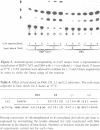Abstract
1731, a Drosophila retrotransposon was first described as having a transcription activity which was negatively regulated by 20-hydroxyecdysone (20-OH), the steroid molting hormone of insects. Using constructions expressing the bacterial chloramphenicol-acetyltransferase (CAT) gene under the control of the entire or deleted Long Terminal Repeats (LTRs) of 1731, we were able to show that a short (28 bp) sequence located in the U3 region of these LTRs was required for 1) the increase in promoter strength, 2) negative regulation by 20-OH and, 3) positive regulation by heat shock.
Full text
PDF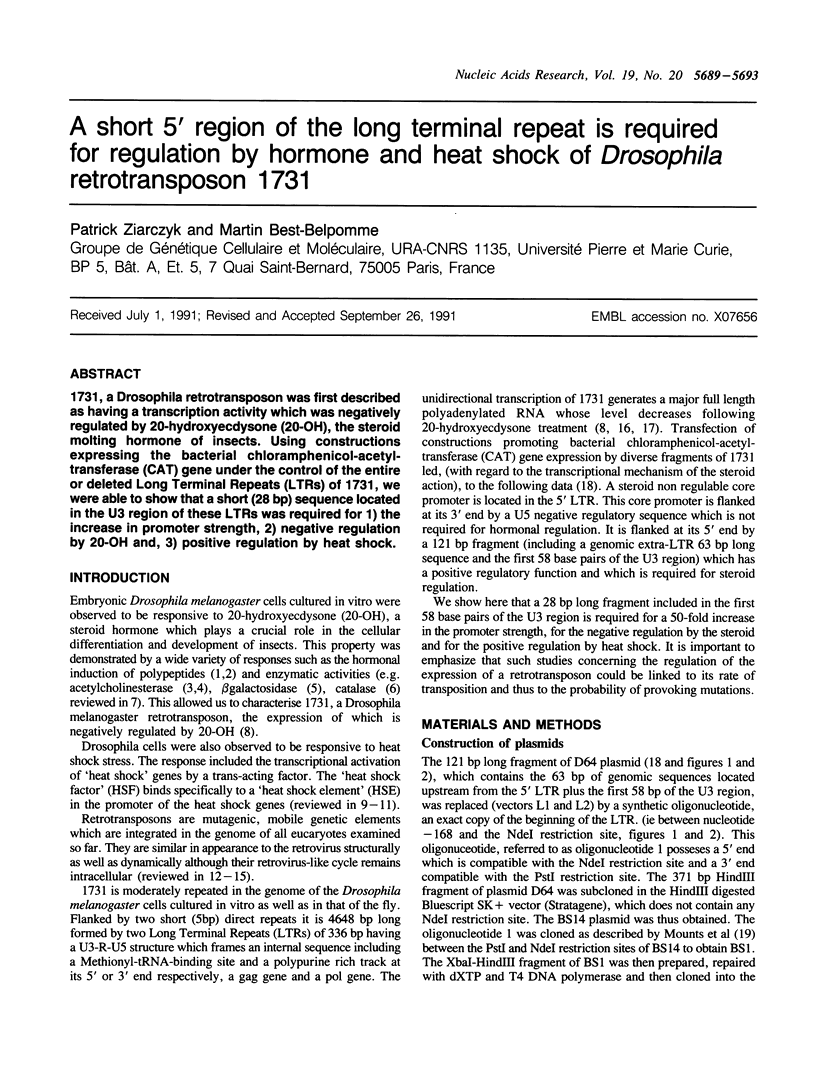
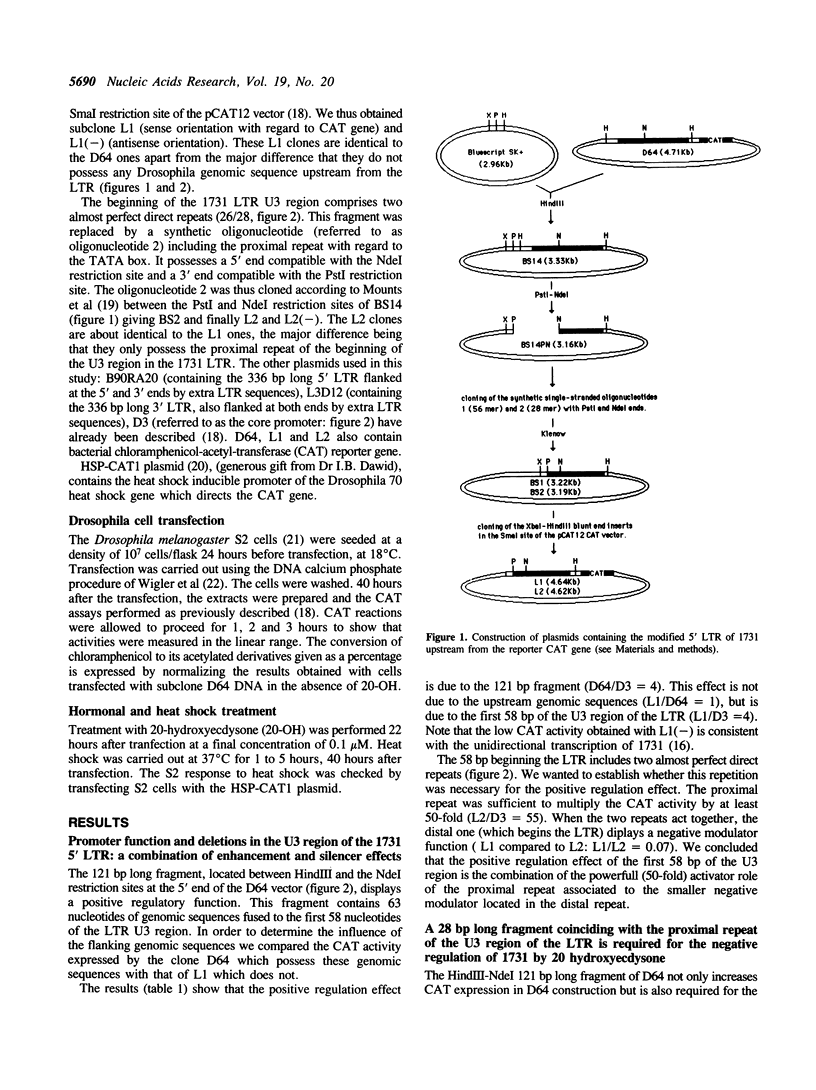

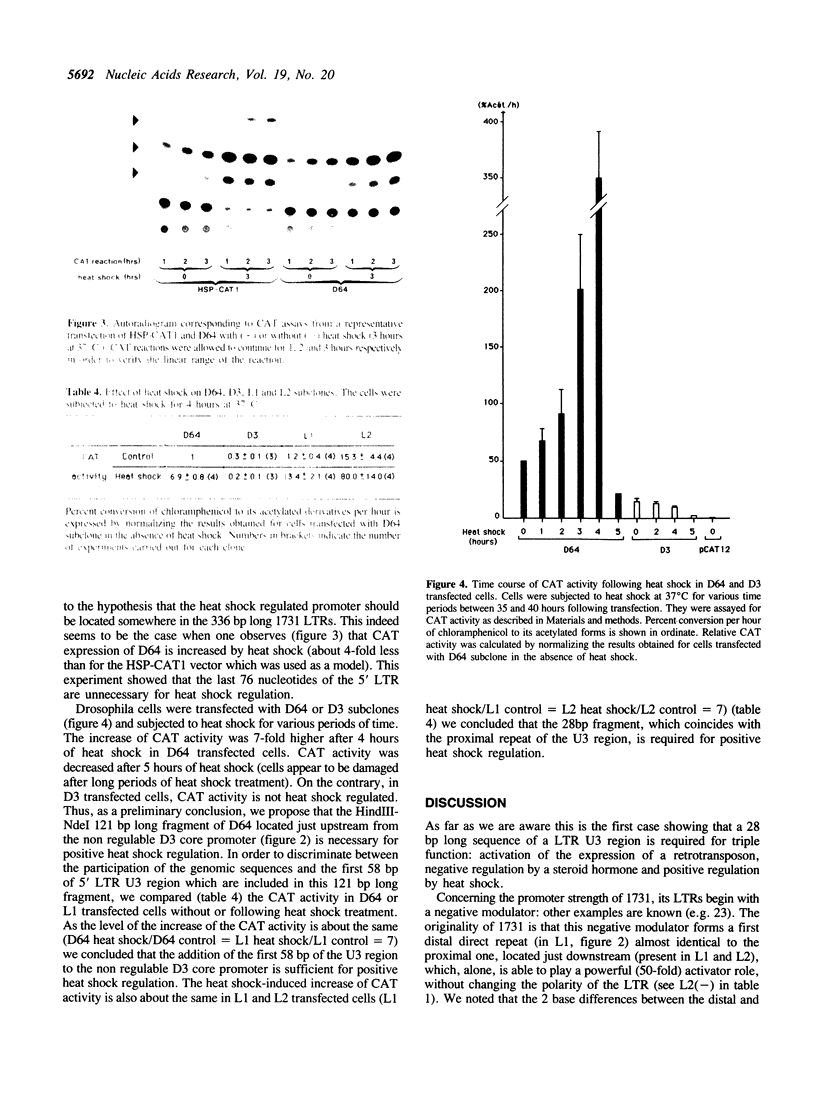
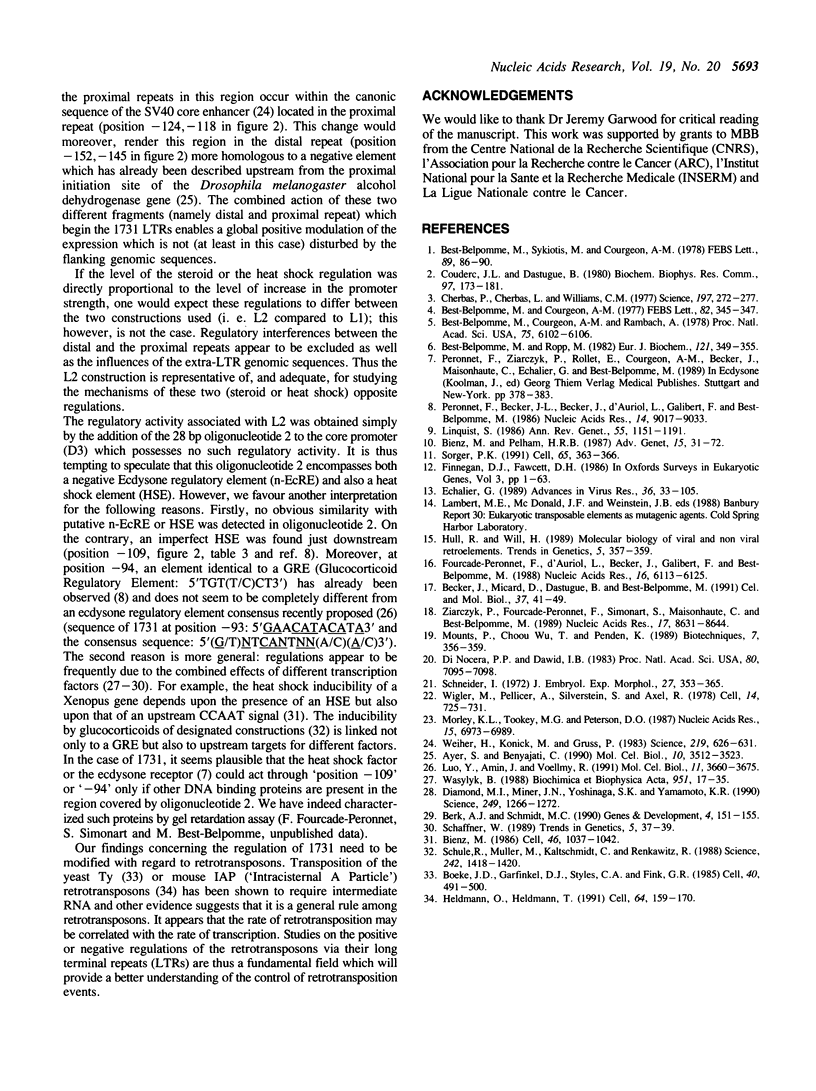
Images in this article
Selected References
These references are in PubMed. This may not be the complete list of references from this article.
- Ayer S., Benyajati C. Conserved enhancer and silencer elements responsible for differential Adh transcription in Drosophila cell lines. Mol Cell Biol. 1990 Jul;10(7):3512–3523. doi: 10.1128/mcb.10.7.3512. [DOI] [PMC free article] [PubMed] [Google Scholar]
- Becker J., Micard D., Becker J. L., Fourcade-Peronnet F., Dastugue B., Best-Belpomme M. Ecdysterone decreases the transcription level of the retrotransposons 1731 and 412 in a Drosophila cell line. Cell Mol Biol. 1991;37(1):41–49. [PubMed] [Google Scholar]
- Best-Belpomme M., Courgeon A. M. Ecdysterone and acetylcholinesterase activity in cultured Drosophila cells. Inducible, non-inducible and constitutive clones or lines. FEBS Lett. 1977 Oct 15;82(2):345–347. doi: 10.1016/0014-5793(77)80617-0. [DOI] [PubMed] [Google Scholar]
- Best-Belpomme M., Courgeon A. M., Rambach A. beta-Galactosidase is induced by hormone in Drosophila melanogaster cell cultures. Proc Natl Acad Sci U S A. 1978 Dec;75(12):6102–6106. doi: 10.1073/pnas.75.12.6102. [DOI] [PMC free article] [PubMed] [Google Scholar]
- Best-Belpomme M., Ropp M. Catalase is induced by ecdysterone and ethanol in Drosophila cells. Eur J Biochem. 1982 Jan;121(2):349–355. doi: 10.1111/j.1432-1033.1982.tb05793.x. [DOI] [PubMed] [Google Scholar]
- Best-Belpomme M., Sykiotis M., Courgeon A. M. Antisera against ecdysteroid-induced proteins in an established line and a clone of Drosophila melanogaster cells. FEBS Lett. 1978 May 1;89(1):86–88. doi: 10.1016/0014-5793(78)80528-6. [DOI] [PubMed] [Google Scholar]
- Bienz M. A CCAAT box confers cell-type-specific regulation on the Xenopus hsp70 gene in oocytes. Cell. 1986 Sep 26;46(7):1037–1042. doi: 10.1016/0092-8674(86)90703-8. [DOI] [PubMed] [Google Scholar]
- Bienz M., Pelham H. R. Mechanisms of heat-shock gene activation in higher eukaryotes. Adv Genet. 1987;24:31–72. doi: 10.1016/s0065-2660(08)60006-1. [DOI] [PubMed] [Google Scholar]
- Boeke J. D., Garfinkel D. J., Styles C. A., Fink G. R. Ty elements transpose through an RNA intermediate. Cell. 1985 Mar;40(3):491–500. doi: 10.1016/0092-8674(85)90197-7. [DOI] [PubMed] [Google Scholar]
- Cherbas P., Cherbas L., Williams C. M. Induction of acetylcholinesterase activity by beta-ecdysone in a Drosophila cell line. Science. 1977 Jul 15;197(4300):275–277. doi: 10.1126/science.877552. [DOI] [PubMed] [Google Scholar]
- Couderc J. L., Dastugue B. Ecdysterone-induced modifications of protein synthesis in a Drosophila melanogaster cultured cell line. Biochem Biophys Res Commun. 1980 Nov 17;97(1):173–181. doi: 10.1016/s0006-291x(80)80151-3. [DOI] [PubMed] [Google Scholar]
- Di Nocera P. P., Dawid I. B. Transient expression of genes introduced into cultured cells of Drosophila. Proc Natl Acad Sci U S A. 1983 Dec;80(23):7095–7098. doi: 10.1073/pnas.80.23.7095. [DOI] [PMC free article] [PubMed] [Google Scholar]
- Diamond M. I., Miner J. N., Yoshinaga S. K., Yamamoto K. R. Transcription factor interactions: selectors of positive or negative regulation from a single DNA element. Science. 1990 Sep 14;249(4974):1266–1272. doi: 10.1126/science.2119054. [DOI] [PubMed] [Google Scholar]
- Echalier G. Drosophila retrotransposons: interactions with genome. Adv Virus Res. 1989;36:33–105. doi: 10.1016/s0065-3527(08)60582-5. [DOI] [PubMed] [Google Scholar]
- Fourcade-Peronnet F., d'Auriol L., Becker J., Galibert F., Best-Belpomme M. Primary structure and functional organization of Drosophila 1731 retrotransposon. Nucleic Acids Res. 1988 Jul 11;16(13):6113–6125. doi: 10.1093/nar/16.13.6113. [DOI] [PMC free article] [PubMed] [Google Scholar]
- Heidmann O., Heidmann T. Retrotransposition of a mouse IAP sequence tagged with an indicator gene. Cell. 1991 Jan 11;64(1):159–170. doi: 10.1016/0092-8674(91)90217-m. [DOI] [PubMed] [Google Scholar]
- Hull R., Will H. Molecular biology of viral and nonviral retroelements. Trends Genet. 1989 Nov;5(11):357–359. doi: 10.1016/0168-9525(89)90151-0. [DOI] [PubMed] [Google Scholar]
- Luo Y., Amin J., Voellmy R. Ecdysterone receptor is a sequence-specific transcription factor involved in the developmental regulation of heat shock genes. Mol Cell Biol. 1991 Jul;11(7):3660–3675. doi: 10.1128/mcb.11.7.3660. [DOI] [PMC free article] [PubMed] [Google Scholar]
- Morley K. L., Toohey M. G., Peterson D. O. Transcriptional repression of a hormone-responsive promoter. Nucleic Acids Res. 1987 Sep 11;15(17):6973–6989. doi: 10.1093/nar/15.17.6973. [DOI] [PMC free article] [PubMed] [Google Scholar]
- Mounts P., Wu T. C., Peden K. Method for cloning single-stranded oligonucleotides in a plasmid vector. Biotechniques. 1989 Apr;7(4):356–359. [PubMed] [Google Scholar]
- Peronnet F., Becker J. L., Becker J., d'Auriol L., Galibert F., Best-Belpomme M. 1731, a new retrotransposon with hormone modulated expression. Nucleic Acids Res. 1986 Nov 25;14(22):9017–9033. doi: 10.1093/nar/14.22.9017. [DOI] [PMC free article] [PubMed] [Google Scholar]
- Schaffner W. How do different transcription factors binding the same DNA sequence sort out their jobs? Trends Genet. 1989 Feb;5(2):37–39. doi: 10.1016/0168-9525(89)90017-6. [DOI] [PubMed] [Google Scholar]
- Schneider I. Cell lines derived from late embryonic stages of Drosophila melanogaster. J Embryol Exp Morphol. 1972 Apr;27(2):353–365. [PubMed] [Google Scholar]
- Schüle R., Muller M., Kaltschmidt C., Renkawitz R. Many transcription factors interact synergistically with steroid receptors. Science. 1988 Dec 9;242(4884):1418–1420. doi: 10.1126/science.3201230. [DOI] [PubMed] [Google Scholar]
- Sorger P. K. Heat shock factor and the heat shock response. Cell. 1991 May 3;65(3):363–366. doi: 10.1016/0092-8674(91)90452-5. [DOI] [PubMed] [Google Scholar]
- Wasylyk B. Enhancers and transcription factors in the control of gene expression. Biochim Biophys Acta. 1988 Nov 10;951(1):17–35. doi: 10.1016/0167-4781(88)90021-8. [DOI] [PubMed] [Google Scholar]
- Weiher H., König M., Gruss P. Multiple point mutations affecting the simian virus 40 enhancer. Science. 1983 Feb 11;219(4585):626–631. doi: 10.1126/science.6297005. [DOI] [PubMed] [Google Scholar]
- Wigler M., Pellicer A., Silverstein S., Axel R. Biochemical transfer of single-copy eucaryotic genes using total cellular DNA as donor. Cell. 1978 Jul;14(3):725–731. doi: 10.1016/0092-8674(78)90254-4. [DOI] [PubMed] [Google Scholar]
- Ziarczyk P., Fourcade-Peronnet F., Simonart S., Maisonhaute C., Best-Belpomme M. Functional analysis of the long terminal repeats of Drosophila 1731 retrotransposon: promoter function and steroid regulation. Nucleic Acids Res. 1989 Nov 11;17(21):8631–8644. doi: 10.1093/nar/17.21.8631. [DOI] [PMC free article] [PubMed] [Google Scholar]



